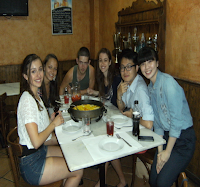Salamanca is known as one of the most culturally rich cities of Spain. It’s known for having a wide array of monuments, churches, museums, ancient cathedrals and universities but it is also a city in where different famous persons have lived and passed along the story of the city. Highlighted in this article is Miguel de Unamuno, whose work is known and appreciated all over the world; a famous character who made a great contribution in the field of philosophy.
One of the most visited tourist destinations in Salamanca is the "Unamuno House Museum", in which the philosopher lived and today is open to the public. The house is in the old part of the city. At first it was owned by the University of Salamanca. Built in the eighteenth century, it became famous as the place where Miguel de Unamuno lived as Rector of the University of Salamanca and in the 50's it was converted into a museum dedicated to the writer's life. Today the house/museum is integrated into the Office of Archives and Libraries of the University of Salamanca.
In preparation to becoming a museum, work began in 1952 by adding furniture on the second floor and creating Unamuno's personal library (assigned to the University) with its 6000 books. Between 1976 and 1977 spaces in the house were adapted to create a historical spectrum which recreates the atmosphere of the writer; work would end in 1996 when the museum was officially opened to the public.
The house built between 1758 and 1762 by architect Andrés García de Quiñones, was converted into the house of the Rector of the University of Salamanca and used by the school Administration. Later on it was occupied by Unamuno when he moved to Salamanca in 1900 to teach Greek at the University. He took over the second floor of the house to devote himself to writing his works and poetry. The building is located on a street of booksellers, on the corner of Calderon de la Barca.
The façade of the building bears the shield of the University of Salamanca in quoting the following sentence: "OMNIVM SCIENTARVM PRINCEPS SALMANTICA DOCET” which loosely translated means Salamanca is the first in the teaching of all sciences. The building, rectangular in shape, is divided into two parts: the first floor is the Official Hall, while the second are offices. I advise those interested in philosophy and who are lovers of culture, to visit and to experience this journey to the past thanks to the perfect preservation and restoration of this building!
Valeria, student internship in Tía Tula.
 To give you a little history on the origins of Paella, It is
a Spanish rice dish which originated in Valencia in the mid-19th
century and is considered to be Valencia’s regional dish but it is popular
throughout Spain. In typical Valencia tradition the dish is made with rice,
vegetable, rabbit and chicken meat, beans, saffron, oil and seasoning. Other
paellas are also made with Seafood or there may be a combination of both.
To give you a little history on the origins of Paella, It is
a Spanish rice dish which originated in Valencia in the mid-19th
century and is considered to be Valencia’s regional dish but it is popular
throughout Spain. In typical Valencia tradition the dish is made with rice,
vegetable, rabbit and chicken meat, beans, saffron, oil and seasoning. Other
paellas are also made with Seafood or there may be a combination of both.




